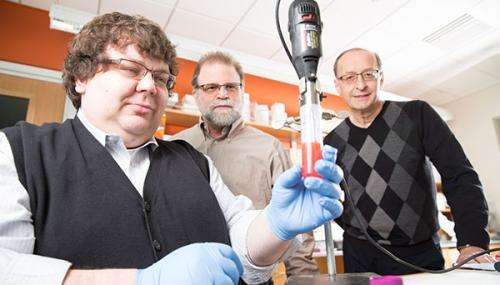Golden vehicle for drug delivery has hidden costs

One of the biggest ideas in treating disease involves material so small it isn't even visible. Miniscule gold particles – the size of several atoms – are being touted as vehicles to send drugs exactly where they are needed in the body, minimizing side effects and the dosage needed.
But a recent UWM study has found that while engineered gold nanoparticles are attractive for smart drug delivery, they come with a downside: great potential to disrupt a woman's fertility.
"We're calling them an emerging class of novel endocrine disruptors," said Reinhold Hutz, professor of biological sciences. "This study is the first one to look at toxic effects of gold nanoparticles in living ovarian tissue, so it's very early evidence."
Endocrine disruptors are chemicals that, even in trace amounts, confuse the complicated hormonal messaging system, altering or interrupting a wide range of normal cell activities.
They include pesticides, plasticizers in food containers and flame retardants applied to clothing. Each can be toxic to humans in different ways.
The UWM study was one of the first to investigate nanoparticles as endocrine disruptors.
Nanoparticles are everywhere
Understanding how gold nanoparticles affect the body is important because they are beginning to be used for drug delivery in humans, said Jeremy Larson, a former master's student in the Department of Biological Sciences who conducted much of the research.
Also, nanoparticles of various materials, not just gold, are becoming more prevalent as ingredients in consumer products ranging from food packaging to personal care items, like sunscreens.
Larson determined that gold nanoparticles affected production of progesterone, a sex steroid hormone that affects the production of estrogen and testosterone. Though the change was subtle, he said, it was detected at an amount that is 200,000-fold lower than the dose for clinical use.
"The biochemical pathway we evaluated, called steroidogenesis, is huge," said Larson. "It doesn't just include progesterone and estrogen production, but also production of stress hormones and other products, depending on the tissue type."
That means it is possible that nanoparticles may cause changes in bodily functions other than reproduction that involve estrogen, such as the immune system and brain functioning.
Hutz and Larson worked on the study with Michael Carvan's toxicology lab at UWM's School of Freshwater Sciences. Carvan's lab and the Children's Environmental Health Sciences Core Center provided the funding.
Smaller nanoparticles may do more damage
Larson, Carvan and Hutz limited their study to the effects in ovarian tissue, but other studies in rats have shown that gold nanoparticles deposited in male reproductive organs can alter testosterone.
Much more research is needed to determine a more comprehensive picture of the health impacts of nanoparticles. That work will take time, Hutz said.
"Because nanoparticles all vary in size, composition and behavior, they will have to be investigated one at a time," he said.
Another obstacle to studying nanoparticles is that at the atomic scale, molecules behave differently than they would in bulk.
"There are levels of complexity," Larson said. "Typically, the smaller the nanoparticle, the greater its potential to interact with the environment."
Hutz believes the particles might be less harmful if their chemical structures were modified to limit their activity within the cells.
More information: "Low-dose gold nanoparticles exert subtle endocrine-modulating effects on the ovarian steroidogenic pathway ex vivo independent of oxidative stress." Informa Healthcare DOI: 10.3109/17435390.2013.837208
Provided by University of Wisconsin - Milwaukee




















